AF302 Report: Blockchain Technology Analysis and Business Applications
VerifiedAdded on 2022/10/11
|8
|2109
|22
Report
AI Summary
This report explores blockchain technology, defining it as an innovative method for recording information, particularly financial transactions. It examines the advantages, such as enhanced security, fraud prevention, and faster transaction processes. The report also discusses the disadvantages, including security risks, data modification limitations, and storage issues. A case study of Ex-Qantas's planned implementation of blockchain technology is included, highlighting its potential to improve payment systems and supply chain management. The report concludes that blockchain technology offers significant benefits for businesses but also presents challenges that must be addressed for successful implementation. The report uses APA referencing style and adheres to the word count and other requirements outlined in the assignment brief.
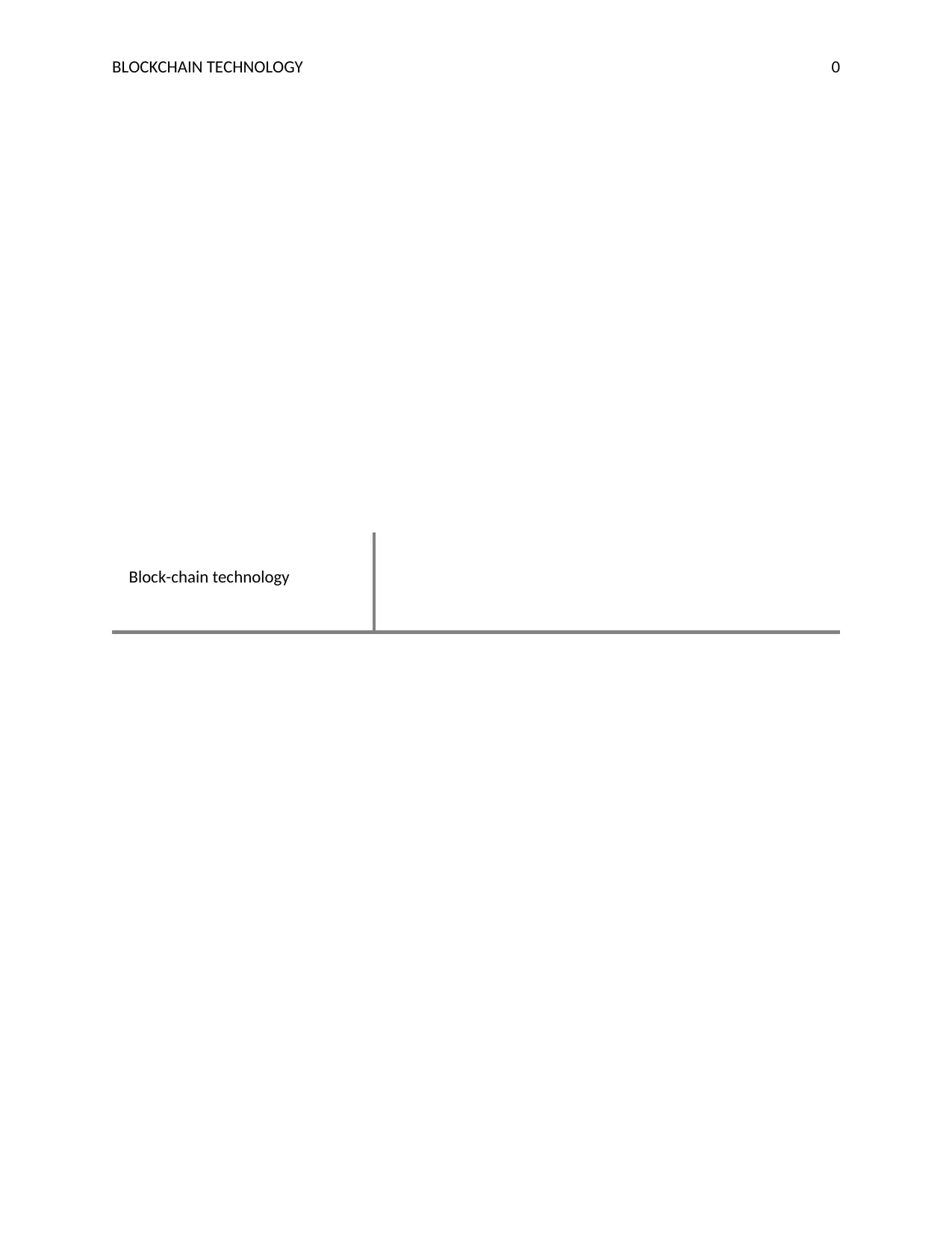
BLOCKCHAIN TECHNOLOGY 0
Block-chain technology
Block-chain technology
Paraphrase This Document
Need a fresh take? Get an instant paraphrase of this document with our AI Paraphraser
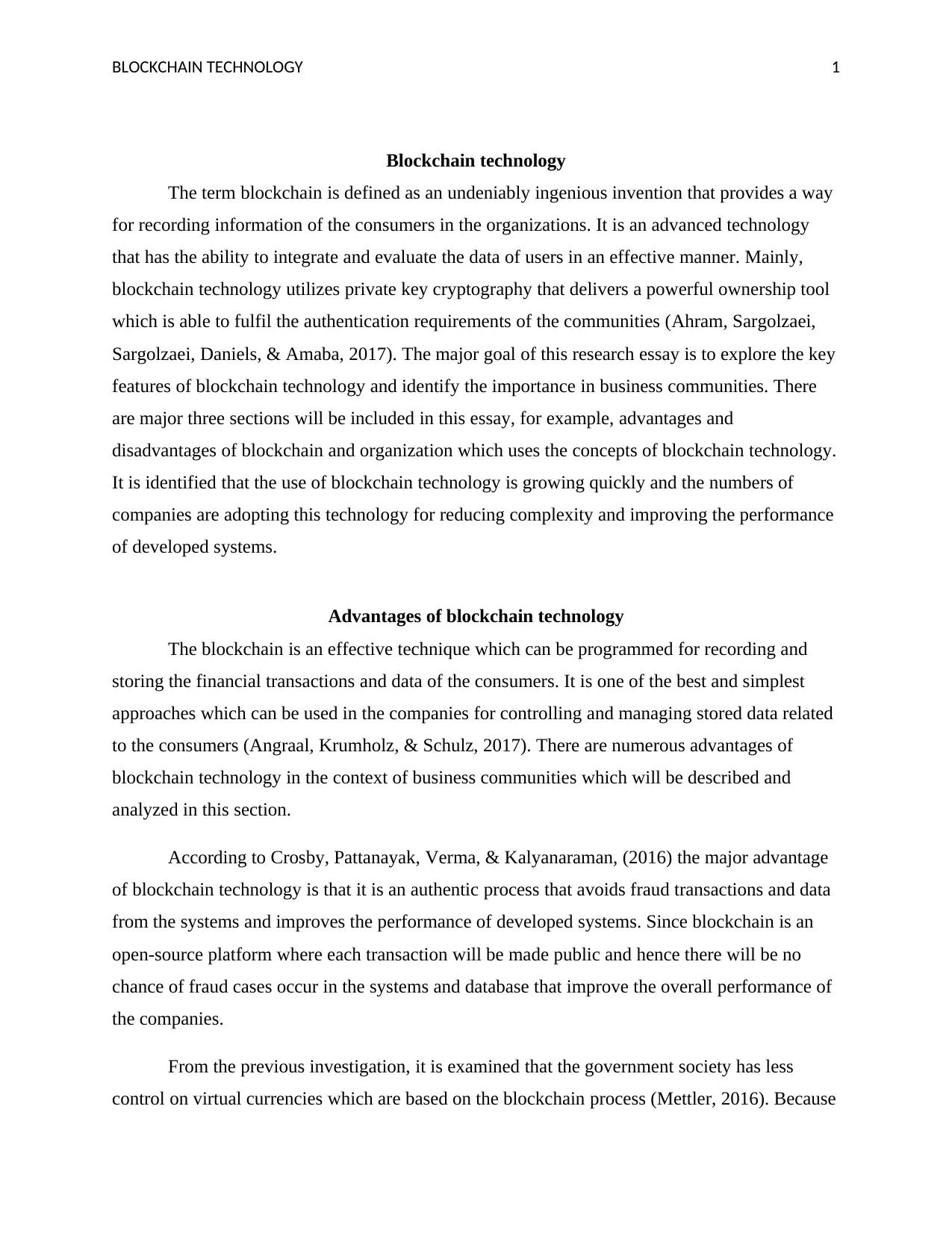
BLOCKCHAIN TECHNOLOGY 1
Blockchain technology
The term blockchain is defined as an undeniably ingenious invention that provides a way
for recording information of the consumers in the organizations. It is an advanced technology
that has the ability to integrate and evaluate the data of users in an effective manner. Mainly,
blockchain technology utilizes private key cryptography that delivers a powerful ownership tool
which is able to fulfil the authentication requirements of the communities (Ahram, Sargolzaei,
Sargolzaei, Daniels, & Amaba, 2017). The major goal of this research essay is to explore the key
features of blockchain technology and identify the importance in business communities. There
are major three sections will be included in this essay, for example, advantages and
disadvantages of blockchain and organization which uses the concepts of blockchain technology.
It is identified that the use of blockchain technology is growing quickly and the numbers of
companies are adopting this technology for reducing complexity and improving the performance
of developed systems.
Advantages of blockchain technology
The blockchain is an effective technique which can be programmed for recording and
storing the financial transactions and data of the consumers. It is one of the best and simplest
approaches which can be used in the companies for controlling and managing stored data related
to the consumers (Angraal, Krumholz, & Schulz, 2017). There are numerous advantages of
blockchain technology in the context of business communities which will be described and
analyzed in this section.
According to Crosby, Pattanayak, Verma, & Kalyanaraman, (2016) the major advantage
of blockchain technology is that it is an authentic process that avoids fraud transactions and data
from the systems and improves the performance of developed systems. Since blockchain is an
open-source platform where each transaction will be made public and hence there will be no
chance of fraud cases occur in the systems and database that improve the overall performance of
the companies.
From the previous investigation, it is examined that the government society has less
control on virtual currencies which are based on the blockchain process (Mettler, 2016). Because
Blockchain technology
The term blockchain is defined as an undeniably ingenious invention that provides a way
for recording information of the consumers in the organizations. It is an advanced technology
that has the ability to integrate and evaluate the data of users in an effective manner. Mainly,
blockchain technology utilizes private key cryptography that delivers a powerful ownership tool
which is able to fulfil the authentication requirements of the communities (Ahram, Sargolzaei,
Sargolzaei, Daniels, & Amaba, 2017). The major goal of this research essay is to explore the key
features of blockchain technology and identify the importance in business communities. There
are major three sections will be included in this essay, for example, advantages and
disadvantages of blockchain and organization which uses the concepts of blockchain technology.
It is identified that the use of blockchain technology is growing quickly and the numbers of
companies are adopting this technology for reducing complexity and improving the performance
of developed systems.
Advantages of blockchain technology
The blockchain is an effective technique which can be programmed for recording and
storing the financial transactions and data of the consumers. It is one of the best and simplest
approaches which can be used in the companies for controlling and managing stored data related
to the consumers (Angraal, Krumholz, & Schulz, 2017). There are numerous advantages of
blockchain technology in the context of business communities which will be described and
analyzed in this section.
According to Crosby, Pattanayak, Verma, & Kalyanaraman, (2016) the major advantage
of blockchain technology is that it is an authentic process that avoids fraud transactions and data
from the systems and improves the performance of developed systems. Since blockchain is an
open-source platform where each transaction will be made public and hence there will be no
chance of fraud cases occur in the systems and database that improve the overall performance of
the companies.
From the previous investigation, it is examined that the government society has less
control on virtual currencies which are based on the blockchain process (Mettler, 2016). Because
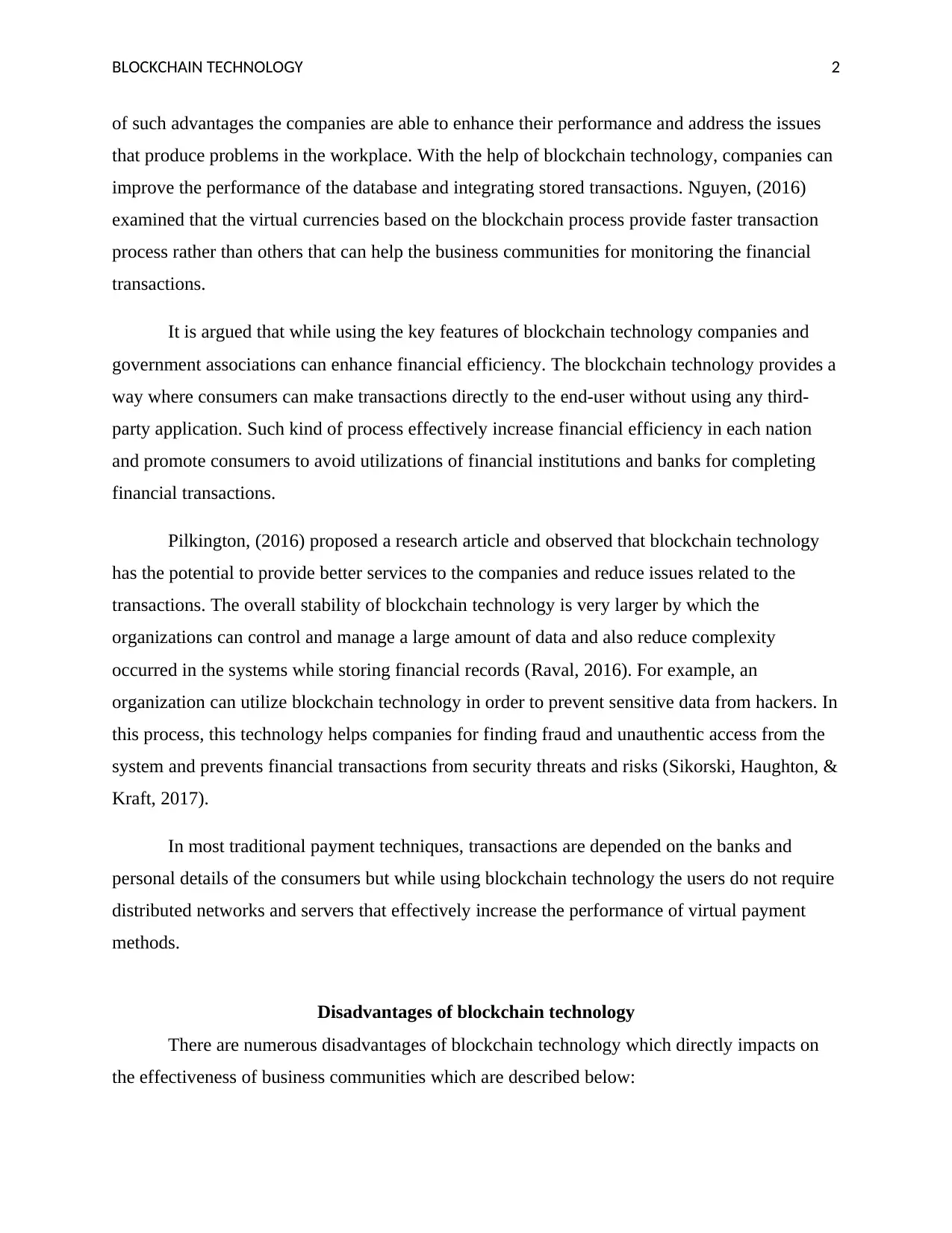
BLOCKCHAIN TECHNOLOGY 2
of such advantages the companies are able to enhance their performance and address the issues
that produce problems in the workplace. With the help of blockchain technology, companies can
improve the performance of the database and integrating stored transactions. Nguyen, (2016)
examined that the virtual currencies based on the blockchain process provide faster transaction
process rather than others that can help the business communities for monitoring the financial
transactions.
It is argued that while using the key features of blockchain technology companies and
government associations can enhance financial efficiency. The blockchain technology provides a
way where consumers can make transactions directly to the end-user without using any third-
party application. Such kind of process effectively increase financial efficiency in each nation
and promote consumers to avoid utilizations of financial institutions and banks for completing
financial transactions.
Pilkington, (2016) proposed a research article and observed that blockchain technology
has the potential to provide better services to the companies and reduce issues related to the
transactions. The overall stability of blockchain technology is very larger by which the
organizations can control and manage a large amount of data and also reduce complexity
occurred in the systems while storing financial records (Raval, 2016). For example, an
organization can utilize blockchain technology in order to prevent sensitive data from hackers. In
this process, this technology helps companies for finding fraud and unauthentic access from the
system and prevents financial transactions from security threats and risks (Sikorski, Haughton, &
Kraft, 2017).
In most traditional payment techniques, transactions are depended on the banks and
personal details of the consumers but while using blockchain technology the users do not require
distributed networks and servers that effectively increase the performance of virtual payment
methods.
Disadvantages of blockchain technology
There are numerous disadvantages of blockchain technology which directly impacts on
the effectiveness of business communities which are described below:
of such advantages the companies are able to enhance their performance and address the issues
that produce problems in the workplace. With the help of blockchain technology, companies can
improve the performance of the database and integrating stored transactions. Nguyen, (2016)
examined that the virtual currencies based on the blockchain process provide faster transaction
process rather than others that can help the business communities for monitoring the financial
transactions.
It is argued that while using the key features of blockchain technology companies and
government associations can enhance financial efficiency. The blockchain technology provides a
way where consumers can make transactions directly to the end-user without using any third-
party application. Such kind of process effectively increase financial efficiency in each nation
and promote consumers to avoid utilizations of financial institutions and banks for completing
financial transactions.
Pilkington, (2016) proposed a research article and observed that blockchain technology
has the potential to provide better services to the companies and reduce issues related to the
transactions. The overall stability of blockchain technology is very larger by which the
organizations can control and manage a large amount of data and also reduce complexity
occurred in the systems while storing financial records (Raval, 2016). For example, an
organization can utilize blockchain technology in order to prevent sensitive data from hackers. In
this process, this technology helps companies for finding fraud and unauthentic access from the
system and prevents financial transactions from security threats and risks (Sikorski, Haughton, &
Kraft, 2017).
In most traditional payment techniques, transactions are depended on the banks and
personal details of the consumers but while using blockchain technology the users do not require
distributed networks and servers that effectively increase the performance of virtual payment
methods.
Disadvantages of blockchain technology
There are numerous disadvantages of blockchain technology which directly impacts on
the effectiveness of business communities which are described below:
⊘ This is a preview!⊘
Do you want full access?
Subscribe today to unlock all pages.

Trusted by 1+ million students worldwide
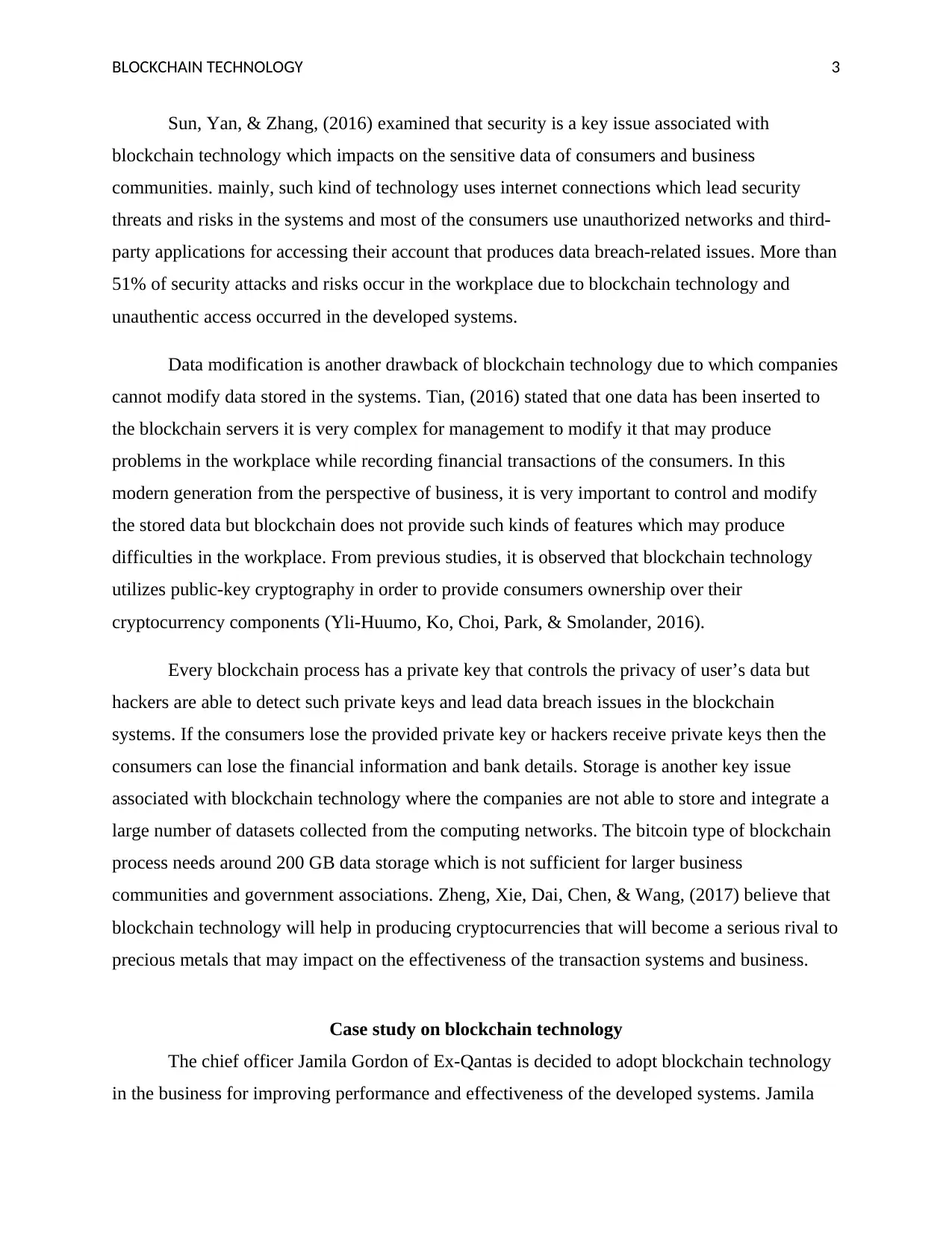
BLOCKCHAIN TECHNOLOGY 3
Sun, Yan, & Zhang, (2016) examined that security is a key issue associated with
blockchain technology which impacts on the sensitive data of consumers and business
communities. mainly, such kind of technology uses internet connections which lead security
threats and risks in the systems and most of the consumers use unauthorized networks and third-
party applications for accessing their account that produces data breach-related issues. More than
51% of security attacks and risks occur in the workplace due to blockchain technology and
unauthentic access occurred in the developed systems.
Data modification is another drawback of blockchain technology due to which companies
cannot modify data stored in the systems. Tian, (2016) stated that one data has been inserted to
the blockchain servers it is very complex for management to modify it that may produce
problems in the workplace while recording financial transactions of the consumers. In this
modern generation from the perspective of business, it is very important to control and modify
the stored data but blockchain does not provide such kinds of features which may produce
difficulties in the workplace. From previous studies, it is observed that blockchain technology
utilizes public-key cryptography in order to provide consumers ownership over their
cryptocurrency components (Yli-Huumo, Ko, Choi, Park, & Smolander, 2016).
Every blockchain process has a private key that controls the privacy of user’s data but
hackers are able to detect such private keys and lead data breach issues in the blockchain
systems. If the consumers lose the provided private key or hackers receive private keys then the
consumers can lose the financial information and bank details. Storage is another key issue
associated with blockchain technology where the companies are not able to store and integrate a
large number of datasets collected from the computing networks. The bitcoin type of blockchain
process needs around 200 GB data storage which is not sufficient for larger business
communities and government associations. Zheng, Xie, Dai, Chen, & Wang, (2017) believe that
blockchain technology will help in producing cryptocurrencies that will become a serious rival to
precious metals that may impact on the effectiveness of the transaction systems and business.
Case study on blockchain technology
The chief officer Jamila Gordon of Ex-Qantas is decided to adopt blockchain technology
in the business for improving performance and effectiveness of the developed systems. Jamila
Sun, Yan, & Zhang, (2016) examined that security is a key issue associated with
blockchain technology which impacts on the sensitive data of consumers and business
communities. mainly, such kind of technology uses internet connections which lead security
threats and risks in the systems and most of the consumers use unauthorized networks and third-
party applications for accessing their account that produces data breach-related issues. More than
51% of security attacks and risks occur in the workplace due to blockchain technology and
unauthentic access occurred in the developed systems.
Data modification is another drawback of blockchain technology due to which companies
cannot modify data stored in the systems. Tian, (2016) stated that one data has been inserted to
the blockchain servers it is very complex for management to modify it that may produce
problems in the workplace while recording financial transactions of the consumers. In this
modern generation from the perspective of business, it is very important to control and modify
the stored data but blockchain does not provide such kinds of features which may produce
difficulties in the workplace. From previous studies, it is observed that blockchain technology
utilizes public-key cryptography in order to provide consumers ownership over their
cryptocurrency components (Yli-Huumo, Ko, Choi, Park, & Smolander, 2016).
Every blockchain process has a private key that controls the privacy of user’s data but
hackers are able to detect such private keys and lead data breach issues in the blockchain
systems. If the consumers lose the provided private key or hackers receive private keys then the
consumers can lose the financial information and bank details. Storage is another key issue
associated with blockchain technology where the companies are not able to store and integrate a
large number of datasets collected from the computing networks. The bitcoin type of blockchain
process needs around 200 GB data storage which is not sufficient for larger business
communities and government associations. Zheng, Xie, Dai, Chen, & Wang, (2017) believe that
blockchain technology will help in producing cryptocurrencies that will become a serious rival to
precious metals that may impact on the effectiveness of the transaction systems and business.
Case study on blockchain technology
The chief officer Jamila Gordon of Ex-Qantas is decided to adopt blockchain technology
in the business for improving performance and effectiveness of the developed systems. Jamila
Paraphrase This Document
Need a fresh take? Get an instant paraphrase of this document with our AI Paraphraser
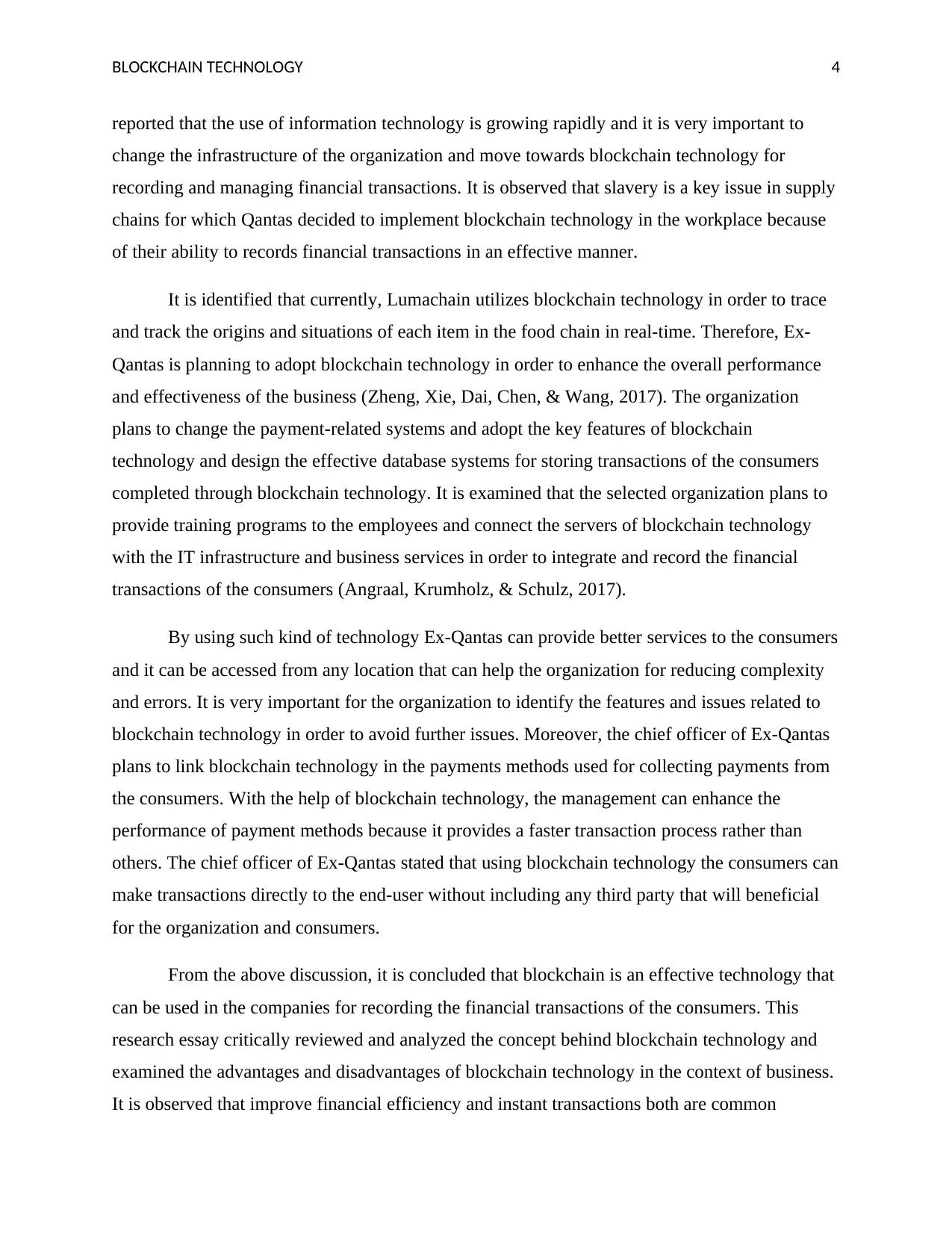
BLOCKCHAIN TECHNOLOGY 4
reported that the use of information technology is growing rapidly and it is very important to
change the infrastructure of the organization and move towards blockchain technology for
recording and managing financial transactions. It is observed that slavery is a key issue in supply
chains for which Qantas decided to implement blockchain technology in the workplace because
of their ability to records financial transactions in an effective manner.
It is identified that currently, Lumachain utilizes blockchain technology in order to trace
and track the origins and situations of each item in the food chain in real-time. Therefore, Ex-
Qantas is planning to adopt blockchain technology in order to enhance the overall performance
and effectiveness of the business (Zheng, Xie, Dai, Chen, & Wang, 2017). The organization
plans to change the payment-related systems and adopt the key features of blockchain
technology and design the effective database systems for storing transactions of the consumers
completed through blockchain technology. It is examined that the selected organization plans to
provide training programs to the employees and connect the servers of blockchain technology
with the IT infrastructure and business services in order to integrate and record the financial
transactions of the consumers (Angraal, Krumholz, & Schulz, 2017).
By using such kind of technology Ex-Qantas can provide better services to the consumers
and it can be accessed from any location that can help the organization for reducing complexity
and errors. It is very important for the organization to identify the features and issues related to
blockchain technology in order to avoid further issues. Moreover, the chief officer of Ex-Qantas
plans to link blockchain technology in the payments methods used for collecting payments from
the consumers. With the help of blockchain technology, the management can enhance the
performance of payment methods because it provides a faster transaction process rather than
others. The chief officer of Ex-Qantas stated that using blockchain technology the consumers can
make transactions directly to the end-user without including any third party that will beneficial
for the organization and consumers.
From the above discussion, it is concluded that blockchain is an effective technology that
can be used in the companies for recording the financial transactions of the consumers. This
research essay critically reviewed and analyzed the concept behind blockchain technology and
examined the advantages and disadvantages of blockchain technology in the context of business.
It is observed that improve financial efficiency and instant transactions both are common
reported that the use of information technology is growing rapidly and it is very important to
change the infrastructure of the organization and move towards blockchain technology for
recording and managing financial transactions. It is observed that slavery is a key issue in supply
chains for which Qantas decided to implement blockchain technology in the workplace because
of their ability to records financial transactions in an effective manner.
It is identified that currently, Lumachain utilizes blockchain technology in order to trace
and track the origins and situations of each item in the food chain in real-time. Therefore, Ex-
Qantas is planning to adopt blockchain technology in order to enhance the overall performance
and effectiveness of the business (Zheng, Xie, Dai, Chen, & Wang, 2017). The organization
plans to change the payment-related systems and adopt the key features of blockchain
technology and design the effective database systems for storing transactions of the consumers
completed through blockchain technology. It is examined that the selected organization plans to
provide training programs to the employees and connect the servers of blockchain technology
with the IT infrastructure and business services in order to integrate and record the financial
transactions of the consumers (Angraal, Krumholz, & Schulz, 2017).
By using such kind of technology Ex-Qantas can provide better services to the consumers
and it can be accessed from any location that can help the organization for reducing complexity
and errors. It is very important for the organization to identify the features and issues related to
blockchain technology in order to avoid further issues. Moreover, the chief officer of Ex-Qantas
plans to link blockchain technology in the payments methods used for collecting payments from
the consumers. With the help of blockchain technology, the management can enhance the
performance of payment methods because it provides a faster transaction process rather than
others. The chief officer of Ex-Qantas stated that using blockchain technology the consumers can
make transactions directly to the end-user without including any third party that will beneficial
for the organization and consumers.
From the above discussion, it is concluded that blockchain is an effective technology that
can be used in the companies for recording the financial transactions of the consumers. This
research essay critically reviewed and analyzed the concept behind blockchain technology and
examined the advantages and disadvantages of blockchain technology in the context of business.
It is observed that improve financial efficiency and instant transactions both are common
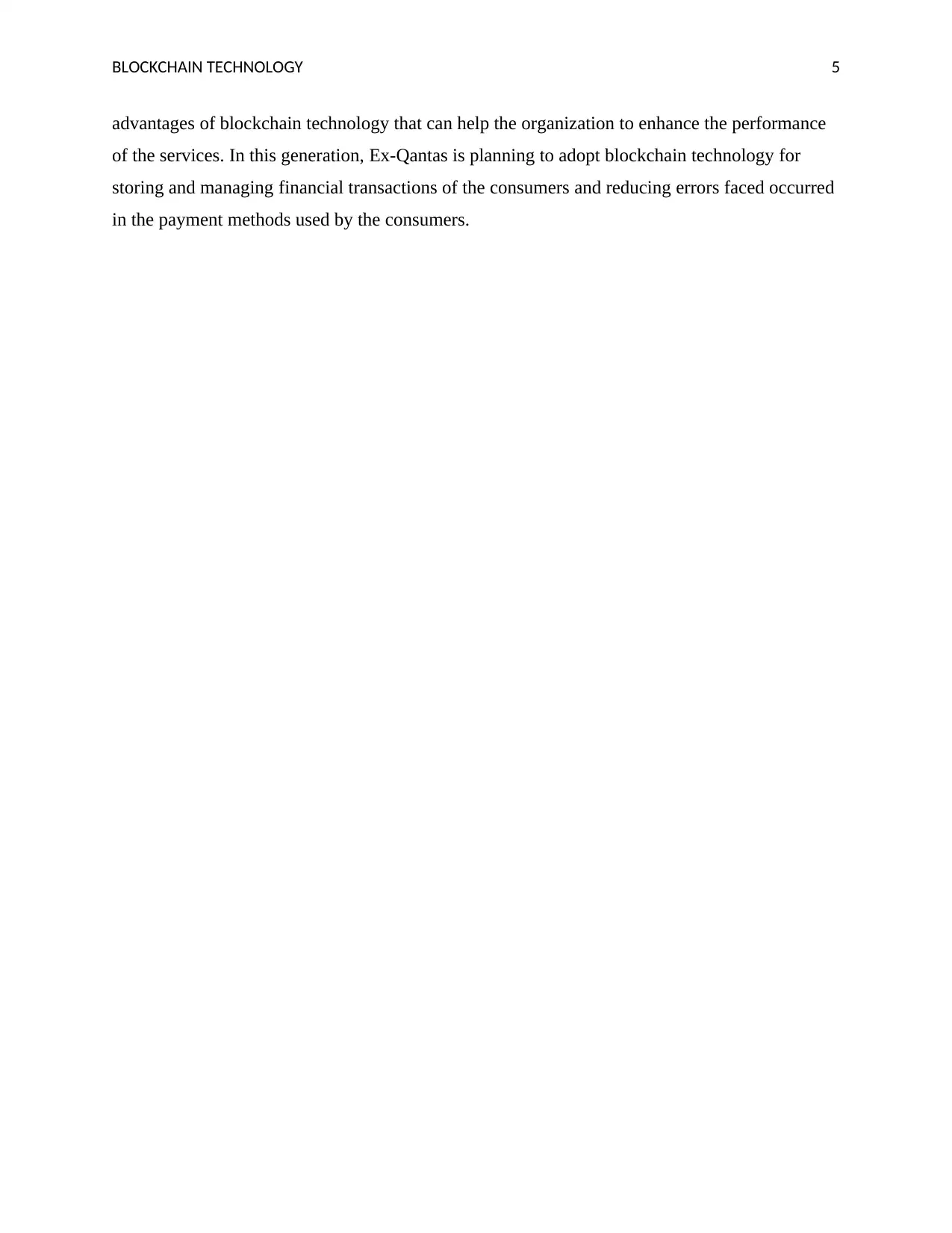
BLOCKCHAIN TECHNOLOGY 5
advantages of blockchain technology that can help the organization to enhance the performance
of the services. In this generation, Ex-Qantas is planning to adopt blockchain technology for
storing and managing financial transactions of the consumers and reducing errors faced occurred
in the payment methods used by the consumers.
advantages of blockchain technology that can help the organization to enhance the performance
of the services. In this generation, Ex-Qantas is planning to adopt blockchain technology for
storing and managing financial transactions of the consumers and reducing errors faced occurred
in the payment methods used by the consumers.
⊘ This is a preview!⊘
Do you want full access?
Subscribe today to unlock all pages.

Trusted by 1+ million students worldwide
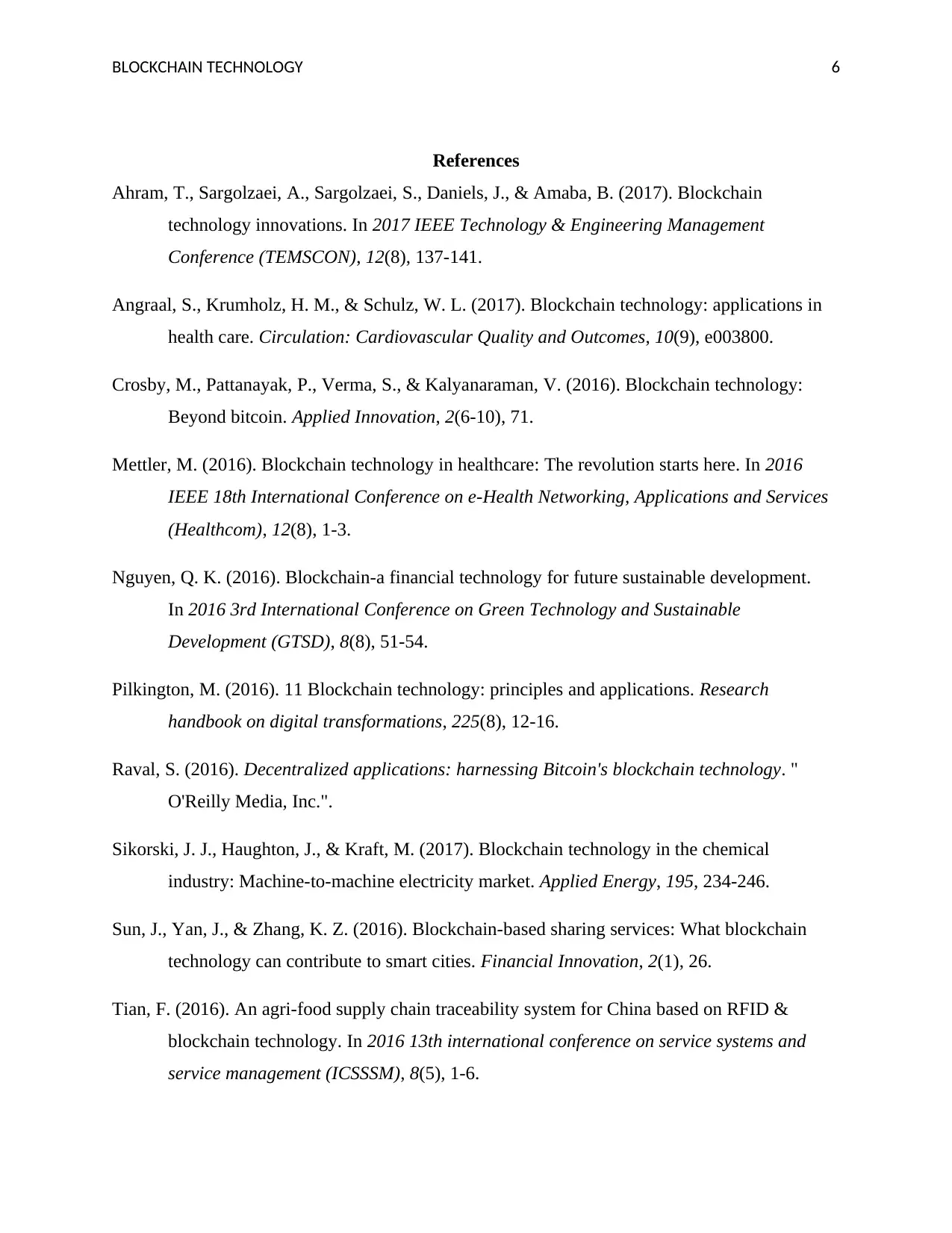
BLOCKCHAIN TECHNOLOGY 6
References
Ahram, T., Sargolzaei, A., Sargolzaei, S., Daniels, J., & Amaba, B. (2017). Blockchain
technology innovations. In 2017 IEEE Technology & Engineering Management
Conference (TEMSCON), 12(8), 137-141.
Angraal, S., Krumholz, H. M., & Schulz, W. L. (2017). Blockchain technology: applications in
health care. Circulation: Cardiovascular Quality and Outcomes, 10(9), e003800.
Crosby, M., Pattanayak, P., Verma, S., & Kalyanaraman, V. (2016). Blockchain technology:
Beyond bitcoin. Applied Innovation, 2(6-10), 71.
Mettler, M. (2016). Blockchain technology in healthcare: The revolution starts here. In 2016
IEEE 18th International Conference on e-Health Networking, Applications and Services
(Healthcom), 12(8), 1-3.
Nguyen, Q. K. (2016). Blockchain-a financial technology for future sustainable development.
In 2016 3rd International Conference on Green Technology and Sustainable
Development (GTSD), 8(8), 51-54.
Pilkington, M. (2016). 11 Blockchain technology: principles and applications. Research
handbook on digital transformations, 225(8), 12-16.
Raval, S. (2016). Decentralized applications: harnessing Bitcoin's blockchain technology. "
O'Reilly Media, Inc.".
Sikorski, J. J., Haughton, J., & Kraft, M. (2017). Blockchain technology in the chemical
industry: Machine-to-machine electricity market. Applied Energy, 195, 234-246.
Sun, J., Yan, J., & Zhang, K. Z. (2016). Blockchain-based sharing services: What blockchain
technology can contribute to smart cities. Financial Innovation, 2(1), 26.
Tian, F. (2016). An agri-food supply chain traceability system for China based on RFID &
blockchain technology. In 2016 13th international conference on service systems and
service management (ICSSSM), 8(5), 1-6.
References
Ahram, T., Sargolzaei, A., Sargolzaei, S., Daniels, J., & Amaba, B. (2017). Blockchain
technology innovations. In 2017 IEEE Technology & Engineering Management
Conference (TEMSCON), 12(8), 137-141.
Angraal, S., Krumholz, H. M., & Schulz, W. L. (2017). Blockchain technology: applications in
health care. Circulation: Cardiovascular Quality and Outcomes, 10(9), e003800.
Crosby, M., Pattanayak, P., Verma, S., & Kalyanaraman, V. (2016). Blockchain technology:
Beyond bitcoin. Applied Innovation, 2(6-10), 71.
Mettler, M. (2016). Blockchain technology in healthcare: The revolution starts here. In 2016
IEEE 18th International Conference on e-Health Networking, Applications and Services
(Healthcom), 12(8), 1-3.
Nguyen, Q. K. (2016). Blockchain-a financial technology for future sustainable development.
In 2016 3rd International Conference on Green Technology and Sustainable
Development (GTSD), 8(8), 51-54.
Pilkington, M. (2016). 11 Blockchain technology: principles and applications. Research
handbook on digital transformations, 225(8), 12-16.
Raval, S. (2016). Decentralized applications: harnessing Bitcoin's blockchain technology. "
O'Reilly Media, Inc.".
Sikorski, J. J., Haughton, J., & Kraft, M. (2017). Blockchain technology in the chemical
industry: Machine-to-machine electricity market. Applied Energy, 195, 234-246.
Sun, J., Yan, J., & Zhang, K. Z. (2016). Blockchain-based sharing services: What blockchain
technology can contribute to smart cities. Financial Innovation, 2(1), 26.
Tian, F. (2016). An agri-food supply chain traceability system for China based on RFID &
blockchain technology. In 2016 13th international conference on service systems and
service management (ICSSSM), 8(5), 1-6.
Paraphrase This Document
Need a fresh take? Get an instant paraphrase of this document with our AI Paraphraser
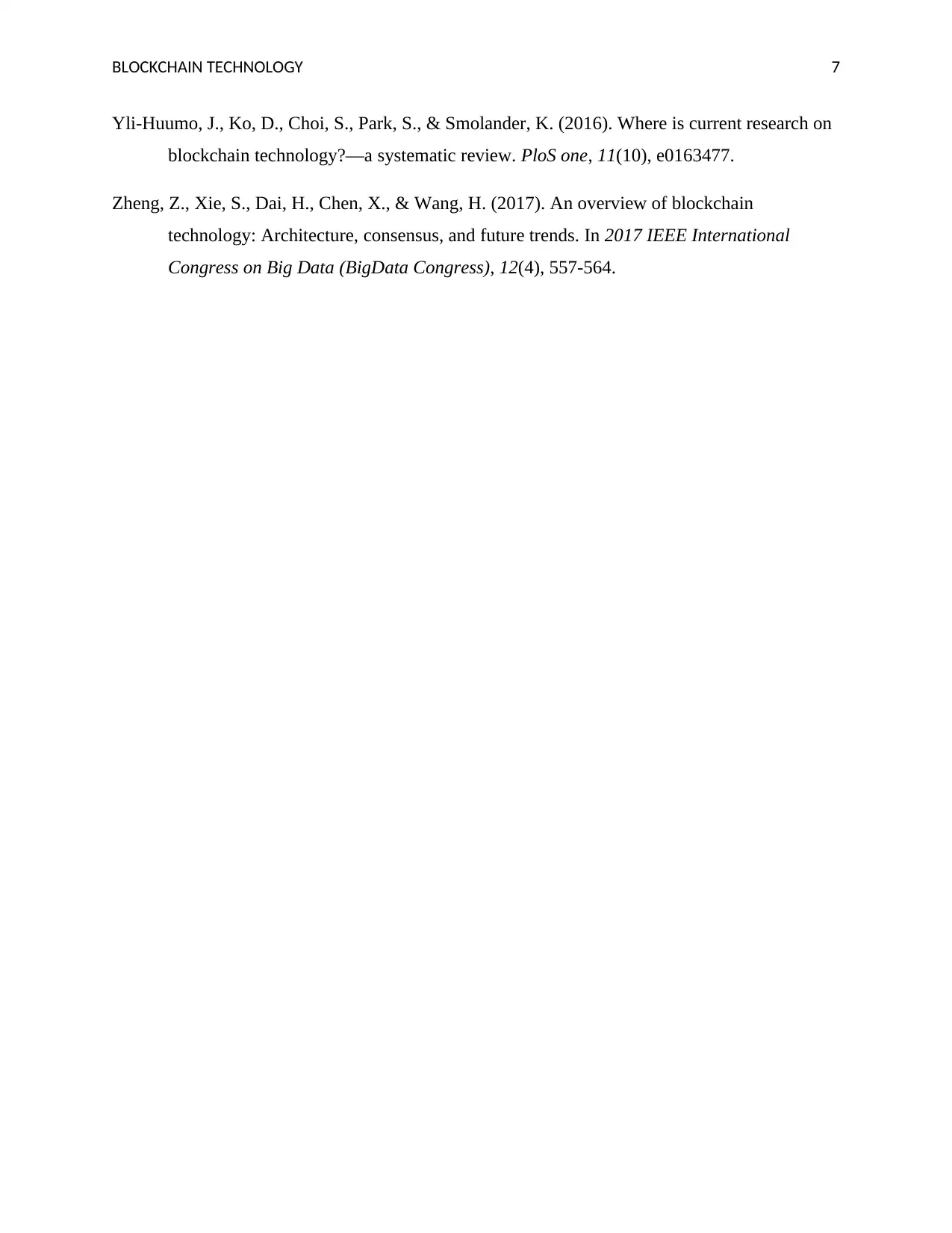
BLOCKCHAIN TECHNOLOGY 7
Yli-Huumo, J., Ko, D., Choi, S., Park, S., & Smolander, K. (2016). Where is current research on
blockchain technology?—a systematic review. PloS one, 11(10), e0163477.
Zheng, Z., Xie, S., Dai, H., Chen, X., & Wang, H. (2017). An overview of blockchain
technology: Architecture, consensus, and future trends. In 2017 IEEE International
Congress on Big Data (BigData Congress), 12(4), 557-564.
Yli-Huumo, J., Ko, D., Choi, S., Park, S., & Smolander, K. (2016). Where is current research on
blockchain technology?—a systematic review. PloS one, 11(10), e0163477.
Zheng, Z., Xie, S., Dai, H., Chen, X., & Wang, H. (2017). An overview of blockchain
technology: Architecture, consensus, and future trends. In 2017 IEEE International
Congress on Big Data (BigData Congress), 12(4), 557-564.
1 out of 8
Related Documents
Your All-in-One AI-Powered Toolkit for Academic Success.
+13062052269
info@desklib.com
Available 24*7 on WhatsApp / Email
![[object Object]](/_next/static/media/star-bottom.7253800d.svg)
Unlock your academic potential
Copyright © 2020–2025 A2Z Services. All Rights Reserved. Developed and managed by ZUCOL.





